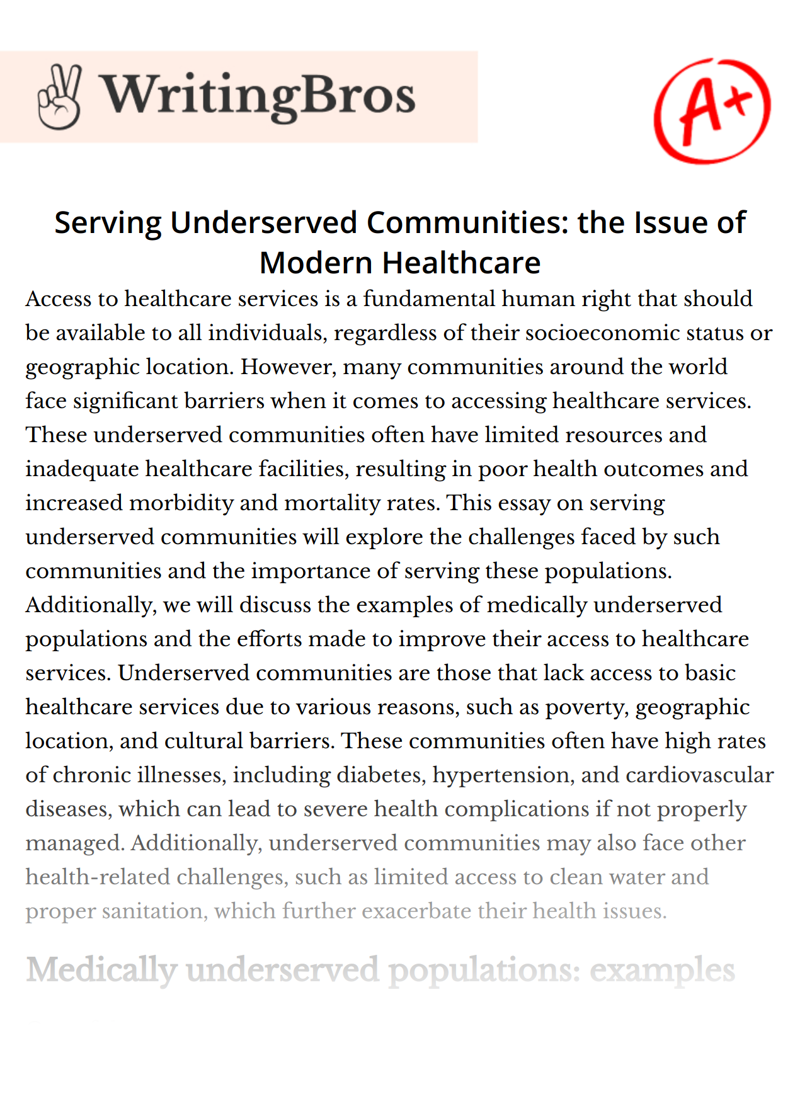Serving Underserved Communities: the Issue of Modern Healthcare

Table of contents
- Medically underserved populations: examples
- Efforts made to improve the situtaion
- References
Access to healthcare services is a fundamental human right that should be available to all individuals, regardless of their socioeconomic status or geographic location. However, many communities around the world face significant barriers when it comes to accessing healthcare services. These underserved communities often have limited resources and inadequate healthcare facilities, resulting in poor health outcomes and increased morbidity and mortality rates. This essay on serving underserved communities will explore the challenges faced by such communities and the importance of serving these populations. Additionally, we will discuss the examples of medically underserved populations and the efforts made to improve their access to healthcare services.
Underserved communities are those that lack access to basic healthcare services due to various reasons, such as poverty, geographic location, and cultural barriers. These communities often have high rates of chronic illnesses, including diabetes, hypertension, and cardiovascular diseases, which can lead to severe health complications if not properly managed. Additionally, underserved communities may also face other health-related challenges, such as limited access to clean water and proper sanitation, which further exacerbate their health issues.
Medically underserved populations: examples
One of the examples of medically underserved populations is rural communities, which often face significant challenges in accessing healthcare services. According to the Health Resources and Services Administration (HRSA), nearly 80 million Americans live in rural areas, where there is a shortage of healthcare providers and limited access to medical facilities. Rural communities often lack specialized medical services, such as mental health, dental, and obstetric care, which are essential for maintaining optimal health outcomes. Moreover, rural communities often have limited transportation options, making it challenging for individuals to travel long distances to access healthcare services.
Another example of underserved communities is low-income neighborhoods, where individuals may not have access to quality healthcare services due to financial constraints. These communities may lack adequate health insurance coverage, resulting in limited access to preventive care services and early diagnosis of chronic illnesses. Furthermore, low-income neighborhoods may have inadequate healthcare facilities, limited medication supply, and untrained healthcare providers, which may further compound the healthcare challenges faced by these communities.
Efforts made to improve the situtaion
The impact of serving underserved communities goes beyond improving their health outcomes; it also benefits society as a whole. Providing quality healthcare services to underserved communities can lead to reduced healthcare costs, decreased absenteeism, and increased productivity. Moreover, serving underserved communities can also help reduce healthcare disparities and promote social equity, which are essential for achieving sustainable development goals.
Several efforts have been made to address the healthcare challenges faced by underserved communities. One of these efforts is the implementation of community health centers, which provide primary healthcare services to underserved populations. Community health centers are typically located in medically underserved areas and provide a range of services, including medical, dental, and behavioral health services. These centers also offer preventive care services, health education programs, and outreach activities to promote healthy lifestyles.
Another effort is the use of telemedicine, which involves the use of technology to provide medical care services to individuals in remote or underserved areas. Telemedicine can help overcome the challenges of limited healthcare facilities and inadequate transportation options by connecting patients with healthcare providers virtually. This technology can also be used to provide medical education and training to healthcare providers in underserved communities.
In conclusion, serving underserved communities is a critical component of promoting health equity and reducing healthcare disparities. Medically underserved populations, such as rural communities and low-income neighborhoods, face significant challenges when it comes to accessing healthcare services. Addressing these challenges requires a multi-faceted approach that includes community-based interventions, healthcare system strengthening, and policy changes. By providing quality healthcare services to underserved communities, we can improve health outcomes, promote social equity, and achieve sustainable development goals.
References
- Institute of Medicine (US) Committee on Monitoring Access to Personal Health Care Services. (1993). Access to healthcare in America. Washington (DC): National Academies Press (US).
- O'Connell, J. J., Oppenheimer, S. C., Judge, C. M., Taube, R. L., Blanchfield, B. B., & Swain-Eng, R. J. (1995). The Boston Health Care for the Homeless Program: a model of care for vulnerable populations. Journal of public health policy, 16(3), 296-306.
- Shi, L., & Singh, D. A. (2017). Delivering health care in America: A systems approach. Jones & Bartlett Learning.
- Institute of Medicine (US) Committee on Monitoring Access to Personal Health Care Services. (1993). Access to healthcare in America. Washington (DC): National Academies Press (US).
- Rust, G., Fryer Jr, G. E., Phillips Jr, R. L., Daniels, E., Strothers III, H., & Satcher, D. (2005). Modifiable determinants of healthcare utilization within the African-American population. Journal of the National Medical Association, 97(7 Suppl), 19S.
- Parchman, M. L., & Pugh Jr, J. A. (2000). Making healthcare accessible to rural populations: the case of federally qualified health centers. The Journal of Rural Health, 16(2), 198-207.
- Arcury, T. A., Preisser, J. S., Gesler, W. M., & Powers, J. M. (2005). Access to transportation and health care utilization in a rural region. The Journal of Rural Health, 21(1), 31-38.
Cite this Essay
To export a reference to this article please select a referencing style below

